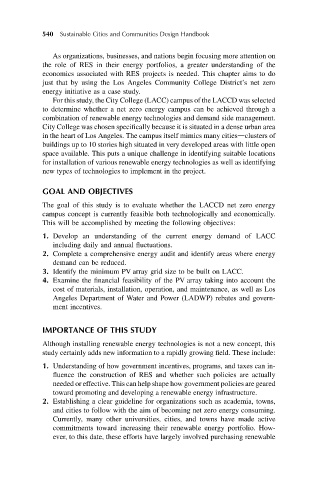Page 571 - Sustainable Cities and Communities Design Handbook
P. 571
540 Sustainable Cities and Communities Design Handbook
As organizations, businesses, and nations begin focusing more attention on
the role of RES in their energy portfolios, a greater understanding of the
economics associated with RES projects is needed. This chapter aims to do
just that by using the Los Angeles Community College District’s net zero
energy initiative as a case study.
For this study, the City College (LACC) campus of the LACCD was selected
to determine whether a net zero energy campus can be achieved through a
combination of renewable energy technologies and demand side management.
City College was chosen specifically because it is situated in a dense urban area
in the heart of Los Angeles. The campus itself mimics many citiesdclusters of
buildings up to 10 stories high situated in very developed areas with little open
space available. This puts a unique challenge in identifying suitable locations
for installation of various renewable energy technologies as well as identifying
new types of technologies to implement in the project.
GOAL AND OBJECTIVES
The goal of this study is to evaluate whether the LACCD net zero energy
campus concept is currently feasible both technologically and economically.
This will be accomplished by meeting the following objectives:
1. Develop an understanding of the current energy demand of LACC
including daily and annual fluctuations.
2. Complete a comprehensive energy audit and identify areas where energy
demand can be reduced.
3. Identify the minimum PV array grid size to be built on LACC.
4. Examine the financial feasibility of the PV array taking into account the
cost of materials, installation, operation, and maintenance, as well as Los
Angeles Department of Water and Power (LADWP) rebates and govern-
ment incentives.
IMPORTANCE OF THIS STUDY
Although installing renewable energy technologies is not a new concept, this
study certainly adds new information to a rapidly growing field. These include:
1. Understanding of how government incentives, programs, and taxes can in-
fluence the construction of RES and whether such policies are actually
needed or effective. This can help shape how government policies are geared
toward promoting and developing a renewable energy infrastructure.
2. Establishing a clear guideline for organizations such as academia, towns,
and cities to follow with the aim of becoming net zero energy consuming.
Currently, many other universities, cities, and towns have made active
commitments toward increasing their renewable energy portfolio. How-
ever, to this date, these efforts have largely involved purchasing renewable

